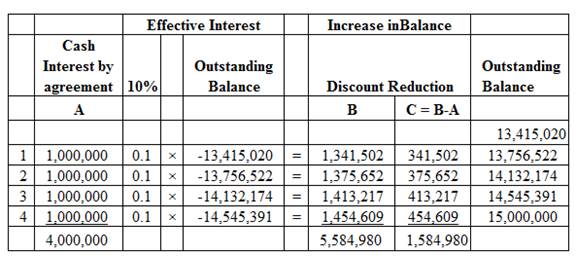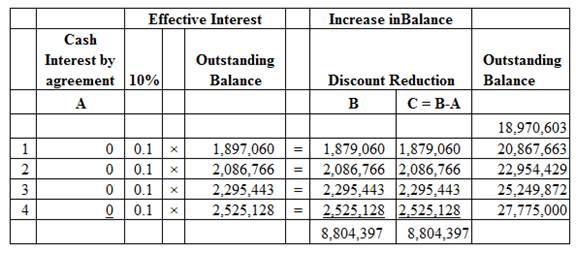
Concept explainers
(1)
Note receivable:
Note receivable refers to a written promise for the amounts to be received within a stipulated period of time. This written promise is issued by a debtor or borrower to lender or creditor. Notes receivable is an asset of a business.
To prepare:
(1)
Explanation of Solution
Journal entries of FL bank are as follows:
FL bank agreed to settle the debt in exchange for land worth $16 million.
| Date | Accounts title and explanation | Post Ref. | Debit ($) |
Credit ($) |
| Land | 16,000,000 | |||
| Loss on debt restructuring | 6,000,000 | |||
| Note receivable | 20,000,000 | |||
| Accrued interest receivable (1) | 2,000,000 | |||
| (To record the settlement of land for the debt) |
Table (1)
Working note:
(2)(a)
Interest accrued from last year.
(2)(a)
Explanation of Solution
| Date | Accounts title and explanation | Post Ref. | Debit ($) |
Credit ($) |
| January 1, 2018 | Loss on troubled debt restructuring | 8,584,980 | ||
| Accrued interest receivable (1) | 2,000,000 | |||
| Note receivable
|
6,584,980 | |||
| (To record accrued interest) |
Table (2)
Working note:
| $ | $ | |
| Previous value: | ||
| Interest Accrued 2017 (1) | 2,000,000 | |
| Principal | 20,000,000 | |
| Carrying amount of the receivables | 22,000,000 | |
| New value: | ||
| Interest
|
3,169,870 | |
| Principal
|
10,245,150 | |
| Present value of the receivable | (13,415,02) | |
| Loss | 8,584,980 |
Table (3)
- PV factor of 3.16987 (Present value of an ordinary annuity of $1: n = 4, i = 10%) is taken from the table value (Refer Table 4 in Appendix from textbook).
- PV factor of 0.68301 (Present value of $1: n = 4, i = 10%) is taken from the table value (Refer Table 2 in Appendix from textbook).
(b)
Reduce the interest payment to $1 Million each:
(b)
Explanation of Solution
| Date | Accounts title and explanation | Post Ref. | Debit ($) |
Credit ($) |
| December 31, 2018 | Cash (required by new agreement) | 1,000,000 | ||
| Note receivable (Balance) | 341,502 | |||
| Interest revenue
|
1,341,502 | |||
| (To record the interest revenue ) |
Table (4)
| Date | Accounts title and explanation | Post Ref. | Debit ($) |
Credit ($) |
| December 31, 2019 | Cash (required by new agreement) | 1,000,000 | ||
| Note receivable (Balance) | 375,652 | |||
| Interest revenue
|
1,375,652 | |||
| (To record the interest revenue ) |
Table (5)
| Date | Accounts title and explanation | Post Ref. | Debit ($) |
Credit ($) |
| December 31, 2020 | Cash (required by new agreement) | 1,000,000 | ||
| Note receivable (Balance) | 413,217 | |||
| Interest revenue
|
1,413,217 | |||
| (To record the interest revenue ) |
Table (6)
| Date | Accounts title and explanation | Post Ref. | Debit ($) |
Credit ($) |
| December 31, 2021 | Cash (required by new agreement) | 1,000,000 | ||
| Note receivable (Balance) | 454,609 | |||
| Interest revenue
|
1,454,609 | |||
| (To record the interest revenue ) |
Table (7)
(c)
Reduce the principal to $15 Million:
(c)
Explanation of Solution
| Date | Accounts title and explanation | Post Ref. | Debit ($) |
Credit ($) |
| December 31, 2021 | Cash (required by new agreement) | 15,000,000 | ||
| Note receivable (Balance) | 15,000,000 | |||
| (To record the principal ) |
Table (8)
Note:
- $15,000,000 is rounded to amortize the note.
Working note:
Amortization schedule:

Image (1)
(3)
To defer all payments until the maturity date:
(3)
Explanation of Solution
| Date | Accounts title and explanation | Post Ref. | Debit ($) |
Credit ($) |
| January 1, 2018 | Loss on troubled debt restructuring | 3,029,397 | ||
| Accrued interest receivable (1) | 2,000,000 | |||
| Note receivable
|
1,029,397 | |||
| (To record the loss on debt ) | ||||
| December 31, 2018 | Note receivable (Balance) | 1,897,060 | ||
| Interest revenue
|
1,897,060 | |||
| (To record the interest revenue ) | ||||
| December 31, 2019 | Note receivable (Balance) | 2,086,766 | ||
| Interest revenue
|
2,086,766 | |||
| (To record the interest revenue ) | ||||
| December 31, 2020 | Note receivable (Balance) | 2,295,443 | ||
| Interest revenue (Refer schedule) | 2,295,443 | |||
| To record the interest revenue ) | ||||
| December 31, 2021 | Note receivable (Balance) | 2,295,443 | ||
| Interest revenue (Refer schedule) | 2,295,443 | |||
| To record the interest revenue ) | ||||
| December 31, 2021 | Cash (required by new agreement) | 27,775,000 | ||
| Note receivable (Balance) | 27,775,000 | |||
| (To record the principal ) | ||||
Table (8)
Working notes:
| $ | |
| Previous value: | |
| Interest Accrued 2017 (1) | 2,000,000 |
| Principal | 20,000,000 |
| Carrying amount of the receivables | |
| New value: | |
| Principal
|
18,970,603 |
| Loss | 3,029,397 |
Table (9)
- PV factor of 0.68301 (Present value of $1: n = 4, i = 10%) is taken from the table value (Refer Table 2 in Appendix from textbook).
Amortization schedule:

Image (2)
Want to see more full solutions like this?
Chapter 7 Solutions
Intermediate Accounting
- What is A&B?arrow_forwardGeneral Accountingarrow_forwardMorgan Corp. purchased $600,000 of 8% bonds of Thompson Inc. on January 1, 2022, paying $567,300. The bonds mature January 1, 2032; interest is payable each July 1 and January 1. The discount of $32,700 provides an effective yield of 9%. Morgan Corp. uses the effective-interest method and plans to hold these bonds to maturity. On July 1, 2022, Morgan Corp. should increase its Held-to-Maturity Debt Securities account for the Thompson Inc. bonds by: a. $3,270 b. $1,635 c. $1,529 d. $978arrow_forward
 Intermediate Accounting: Reporting And AnalysisAccountingISBN:9781337788281Author:James M. Wahlen, Jefferson P. Jones, Donald PagachPublisher:Cengage Learning
Intermediate Accounting: Reporting And AnalysisAccountingISBN:9781337788281Author:James M. Wahlen, Jefferson P. Jones, Donald PagachPublisher:Cengage Learning Financial Reporting, Financial Statement Analysis...FinanceISBN:9781285190907Author:James M. Wahlen, Stephen P. Baginski, Mark BradshawPublisher:Cengage Learning
Financial Reporting, Financial Statement Analysis...FinanceISBN:9781285190907Author:James M. Wahlen, Stephen P. Baginski, Mark BradshawPublisher:Cengage Learning Cornerstones of Financial AccountingAccountingISBN:9781337690881Author:Jay Rich, Jeff JonesPublisher:Cengage Learning
Cornerstones of Financial AccountingAccountingISBN:9781337690881Author:Jay Rich, Jeff JonesPublisher:Cengage Learning



